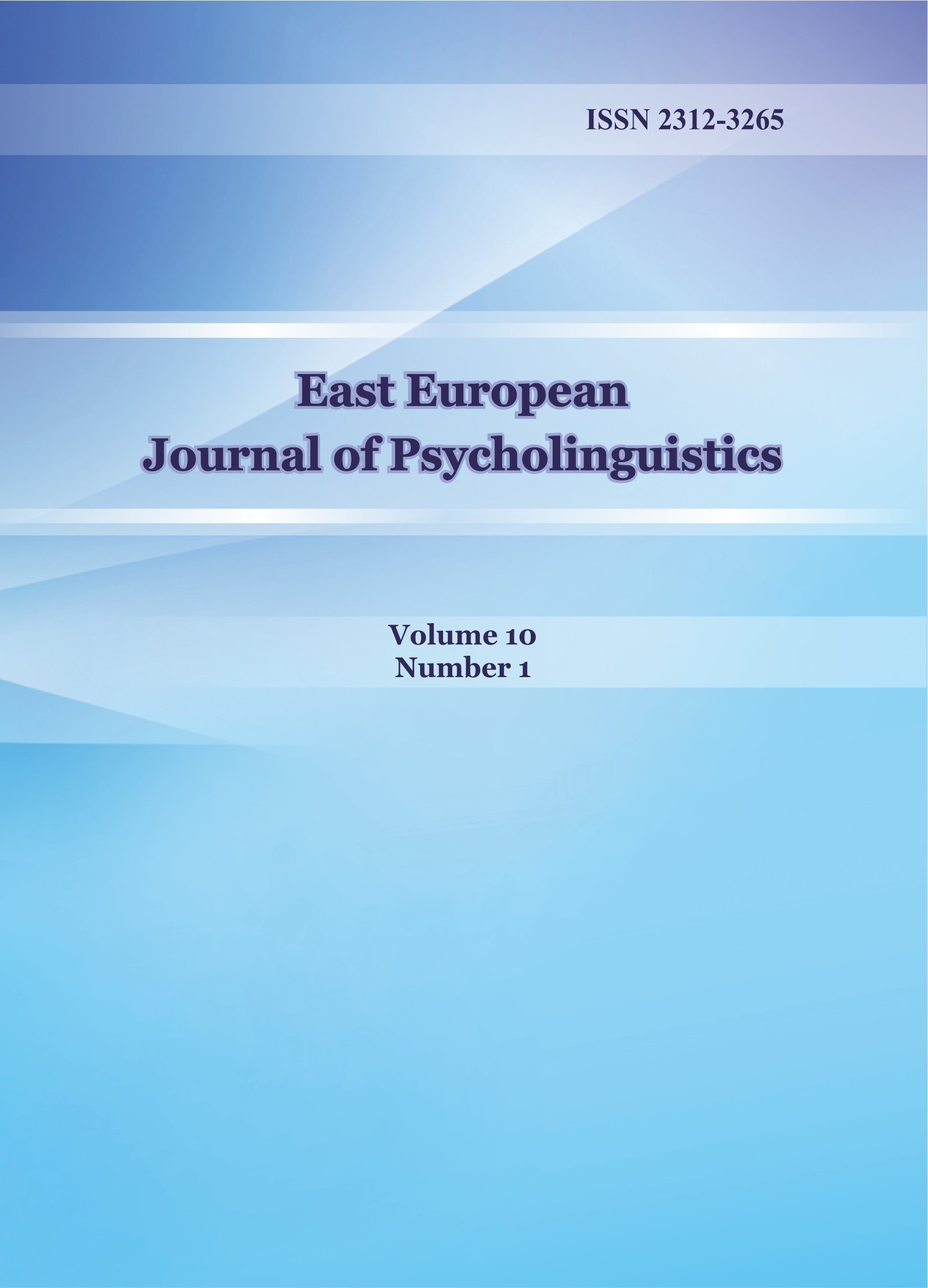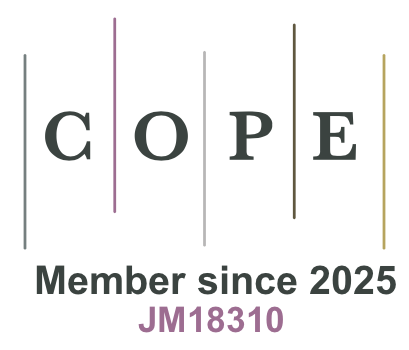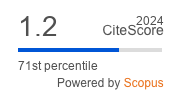Вікові відмінності в тривалості фіксації погляду під час читання новин із негативними текстовими елементами
DOI:
https://doi.org/10.29038/eejpl.2023.10.1.ivaКлючові слова:
масмедіа, пандемія COVID-19, поведінка погляду, фіксація, ай-трекінгАнотація
Всесвітня пандемія COVID-19 призвела до розвитку стресових розладів і зростання суспільної тривожності. Мас-медіа є одним із найвирішальніших факторів, що призводять до розвитку тривоги та стресу в суспільстві під час пандемії. Проте механізми стресогенного впливу ЗМІ залишаються до кінця не з’ясованими. Метою цього дослідження було оцінити вікові особливості поведінки погляду, пов’язані зі сприйняттям інформації, що викликає тривогу. У дослідженні взяли участь 189 добровольців (164 учасники віком від 17 до 22 років (студенти, контрольна група), 25 осіб віком від 59 до 71 року (експериментальна група)). Ми опитали учасників, щоб визначити їхній рівень стресу, депресії та тривоги, та проаналізували дані ай-трекінгу під час сприйняття тексту за допомогою веб-відстеження очей – технології веб-трекінгу EyePass. Результати показали значні вікові відмінності в динаміці зорової уваги під час читання текстів із негативними елементами. Старша доросла група мала меншу середню тривалість фіксації. Різниці між групами за кількістю фіксацій не було. Можна припустити, що окрім віку учасників, на наш результат могли вплинути й інші чинники, а саме професія учасників, викладачів Навчально-наукового інституту журналістики з розвиненими професійними навичками (патерн читання та спосіб сприйняття інформації), але, з іншого боку, більша вразливість до несприятливих наслідків COVID-19 порівняно з молодшими людьми.
Подяки
Автори висловлюють вдячність Національному фонду досліджень України за фінасування та організаційну підтримку (грант "Stressogenic Elements of the Latent Impact of Real Media Reports on the COVID-19 Pandemic on Social Groups" № 2020.01/0050), які уможливили здійснення цього дослідження та одержання експериментальних даних. Дякуємо також представникам Наукової ради фонду, кураторам проєкту; експертам за високу оцінку проєкту; керівництву Київського національного університету імені Тараса Шевченка; колегам і студентам, які зголосилися вязти участь, зробивши внесок у збирання та обробку експериментальних даних.
Декларація щодо конфлікту інтересів
Автори повідомили про відсутність потенційного конфлікту інтересів.
Доступ до даних
Дані цього дослідження - у відкритому доступі на платформі Mendeley Data https://doi.org/10.17632/rpytj9dkmx.3
* Контактна особа для листування: Юрій Гаврилець,
Завантажити
Посилання
Avery, E. J., & Park, S. (2018). HPV vaccination campaign fear visuals: An eye-tracking study exploring effects of visual attention and type on message informative value, recall, and behavioral intentions. Public Relations Review, 44(3), 321-330. https://doi.org/10.1016/j.pubrev.2018.02.005
Ball-Rokeach, S. J., & DeFleur, M.L. (1976). A dependency model of mass media effects. Communication Research, 3, 3-21. https://doi.org/10.1177/009365027600300101
Bakioğlu, F., Korkmaz, O., & Ercan, H. (2021). Fear of COVID-19 and positivity: Mediating role of intolerance of uncertainty, depression, anxiety, and stress. International Journal of Mental Health and Addiction, 19(6), 2369–2382. https://doi.org/10.1007/s11469-020-00331-y
Bendau, A., Petzold, M. B., Pyrkosch, L., Mascarell Maricic, L., Betzler, F., Rogoll, J., Große, J., Ströhle, A., & Plag, J. (2021). Associations between COVID-19 related media consumption and symptoms of anxiety, depression and COVID-19 related fear in the general population in Germany. European Archives of Psychiatry and Clinical Neuroscience, 271(2), 283–291. https://doi.org/10.1007/s00406-020-01171-6
Borges, M. T., Fernandes, E. G., & Coco, M. I. (2020). Age-related differences during visual search: the role of contextual expectations and cognitive control mechanisms. Neuropsychology, Development, and Cognition. A Journal on Normal and Dysfunctional Development, 27(4), 489–516. https://doi.org/10.1080/13825585.2019.1632256
Brashers, D. E., Neidig, J. L., Haas, S. M., Dobbs, L. K., Cardillo, L. W., & Russell, J. A. (2000). Communication in the management of uncertainty: The case of persons living with HIV or AIDS. Communication Monographs, 67(1), 63–84. https://doi.org/10.1080/03637750009376495
Choi, E. P. H., Hui, B. P. H., & Wan, E. Y. F. (2020). Depression and anxiety in Hong Kong during COVID-19. International Journal of Environmental Research and Public Health, 17(10), 3740. https://doi.org/10.3390/ijerph17103740
Daneman, M., Hannon, B., & Burton, C. (2006). Are there age-related differences in shallow semantic processing of text? Evidence from eye movements. Discourse Processes, 42(2), 177–203. https://doi.org/10.1207/s15326950dp4202_5
Downs, C. W., & Adrian, A. D. (2004). Assessing organizational communication: Strategic communication audits. (1st ed.) The Guilford Press.
Gamboz, N., Zamarian, S., & Cavallero, C. (2010). Age-related differences in the attention network test (ANT). Experimental Aging Research, 36(3), 287–305. https://doi.org/10.1080/0361073X.2010.484729
Geise, S. (2014). Eye tracking in media studies. Theory, method, and its exemplary application in analyzing shock-inducing advertisements. In A. N. Valdivia F. Darling-Wolf (Eds.), The International Encyclopedia of Media Studies (pp. 1-26). John Wiley & Sons. https://doi.org/10.1002/9781444361506.wbiems190
Havrylets, Y., Tukaiev, S., Rizun, V., & Shenderovskyj, K. (2019). Impact of TV news on psycho-physiological state depending on emotional burnout. Journal of Content, Community & Communication, 5(9), 13-25. http://dx.doi.org/10.31620/JCCC.06.19/04
Hyland, P., Shevlin, M., McBride, O., Murphy, J., Karatzias, T., Bentall, R. P., Martinez, A., & Vallières, F. (2020). Anxiety and depression in the Republic of Ireland during the COVID-19 pandemic. Acta Psychiatrica Scandinavica, 142(3), 249–256. https://doi.org/10.1111/acps.13219
Kim, K., & Lee, Y. M. (2018). Understanding uncertainty in medicine: concepts and implications in medical education. Korean Journal of Medical Education, 30(3), 181–188. https://doi.org/10.3946/kjme.2018.92
Lang, A. (2006). Using the limited capacity model of motivated mediated message processing to design effective cancer communication messages. Journal of Communication, 56(1), S57-S80. https://doi.org/10.1111/j.1460-2466.2006.00283.x
Liu, C., & Liu, Y. (2020). Media exposure and anxiety during COVID-19: The mediation effect of media vicarious traumatization. International Journal of Environmental Research and Public Health, 17(13), 4720. https://doi.org/10.3390/ijerph17134720
McGowan, V. A., White, S. J., & Paterson, K. B. (2015). The effects of interword spacing on the eye movements of young and older readers. Journal of Cognitive Psychology, 27(5), 609-621. https://doi.org/10.1080/20445911.2014.988157
Mevorach, T., Cohen, J., & Apter, A. (2021). Keep calm and stay safe: The relationship between anxiety and other psychological factors, media exposure and compliance with COVID-19 regulations. International Journal of Environmental Research and Public Health, 18(6), 2852. https://doi.org/10.3390/ijerph18062852
Nidadavolu, L. S., & Walston, J. D. (2021). Underlying vulnerabilities to the cytokine storm and adverse COVID-19 outcomes in the aging immune system. The Journals of Gerontology. Series A. Biological Sciences and Medical Sciences, 76(3), e13-e18. https://doi.org/10.1093/gerona/glaa209
Petzold, M. B., Bendau, A., Plag, J., Pyrkosch, L., Mascarell Maricic, L., Betzler, F., Rogoll, J., Große, J., & Ströhle, A. (2020). Risk, resilience, psychological distress, and anxiety at the beginning of the COVID-19 pandemic in Germany. Brain and Behavior, 10(9), e01745. https://doi.org/10.1002/brb3.1745
Pogorilska, N. I., Synelnykov, R. Y., Palamar, B. I., Tukaiev, S. V., & Nezhyva, L. L. (2021). Features of psychological experiences in severe quarantine during the COVID-19 pandemic: The role of tolerance for uncertainty. Wiadomosci Lekarskie, 74(6), 1312-1316. http://dx.doi.org/10.36740/WLek202106104
Rayner, K., Yang, J., Schuett, S., & Slattery, T. J. (2014). The effect of foveal and parafoveal masks on the eye movements of older and younger readers. Psychology and Aging, 29(2), 205-212. https://doi.org/10.1037/a0036015
Rettie, H., & Daniels, J. (2021). Coping and tolerance of uncertainty: Predictors and mediators of mental health during the COVID-19 pandemic. The American Psychologist, 76(3), 427-437. https://doi.org/10.1037/amp0000710
Rizun, V., Havrylets, Y., Ivaskevych, D., Petrenko-Lysak, A., Popov, A., Tukaiev, S., & Yachnik, Y. (2022). Stressogenic elements of the latent impact of real media reports on the COVID-19 pandemic on social groups (experimental study). Mendeley Data, V3, https://doi.org/10.17632/rpytj9dkmx.3
Salvucci, D. D., & Goldberg, J. H. (2000). Identifying fixations and saccades in eye-tracking protocols. Proceedings of the 2000 symposium on eye tracking research & applications. (71-78). http://dx.doi.org/10.1145/355017.355028.
Stine-Morrow, E.A.L., Gagne, D.D., Morrow, D.G., & DeWall, B.H. (2004). Age differences in rereading. Memory & Cognition, 32, 696-710. https://doi.org/10.3758/BF03195860
Sundar, R. P., Becker, M. W., Bello, N. M., & Bix, L. (2012). Quantifying age-related differences in information processing behaviors when viewing prescription drug labels. PloS One, 7(6), e38819. https://doi.org/10.1371/journal.pone.0038819
Завантаження
Опубліковано
Номер
Розділ
Ліцензія
Авторське право (c) 2023 Daryna Ivaskevych, Anton Popov, Volodymyr Rizun, Yurii Havrylets, Alla Petrenko-Lysak, Yuliia Yachnik, Sergii Tukaiev

Ця робота ліцензується відповідно до ліцензії Creative Commons Attribution 4.0 International License.














 Creative Commons «Attribution» 4.0
Creative Commons «Attribution» 4.0